
Taeniasis
[Taenia asiatica] [Taenia saginata] [Taenia solium]
Causal Agents
The cestodes Taenia saginata (beef tapeworm), T. solium (pork tapeworm) and T. asiatica (Asian tapeworm). Taenia solium can also cause cysticercosis.
Life Cycle
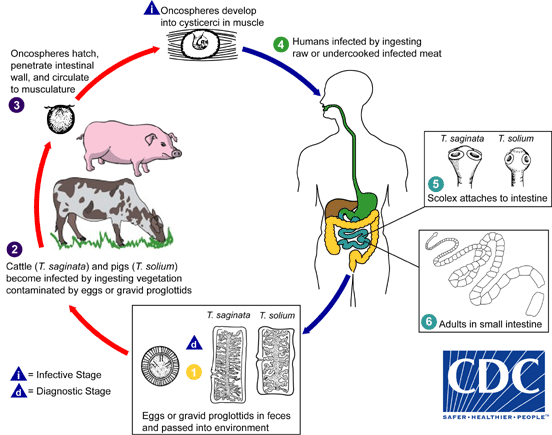
Taeniasis is the infection of humans with the adult tapeworm of Taenia saginata, T. solium or T. asiatica. Humans are the only definitive hosts for these three species. Eggs or gravid proglottids are passed with feces  ; the eggs can survive for days to months in the environment. Cattle (T. saginata) and pigs (T. solium and T. asiatica) become infected by ingesting vegetation contaminated with eggs or gravid proglottids
; the eggs can survive for days to months in the environment. Cattle (T. saginata) and pigs (T. solium and T. asiatica) become infected by ingesting vegetation contaminated with eggs or gravid proglottids  . In the animal's intestine, the oncospheres hatch
. In the animal's intestine, the oncospheres hatch  , invade the intestinal wall, and migrate to the striated muscles, where they develop into cysticerci. A cysticercus can survive for several years in the animal. Humans become infected by ingesting raw or undercooked infected meat
, invade the intestinal wall, and migrate to the striated muscles, where they develop into cysticerci. A cysticercus can survive for several years in the animal. Humans become infected by ingesting raw or undercooked infected meat  . In the human intestine, the cysticercus develops over 2 months into an adult tapeworm, which can survive for years. The adult tapeworms attach to the small intestine by their scolex
. In the human intestine, the cysticercus develops over 2 months into an adult tapeworm, which can survive for years. The adult tapeworms attach to the small intestine by their scolex  and reside in the small intestine
and reside in the small intestine  . Length of adult worms is usually 5 m or less for T. saginata (however it may reach up to 25 m) and 2 to 7 m for T. solium. The adults produce proglottids which mature, become gravid, detach from the tapeworm, and migrate to the anus or are passed in the stool (approximately 6 per day). T. saginata adults usually have 1,000 to 2,000 proglottids, while T. solium adults have an average of 1,000 proglottids. The eggs contained in the gravid proglottids are released after the proglottids are passed with the feces. T. saginata may produce up to 100,000 and T. solium may produce 50,000 eggs per proglottid respectively.
. Length of adult worms is usually 5 m or less for T. saginata (however it may reach up to 25 m) and 2 to 7 m for T. solium. The adults produce proglottids which mature, become gravid, detach from the tapeworm, and migrate to the anus or are passed in the stool (approximately 6 per day). T. saginata adults usually have 1,000 to 2,000 proglottids, while T. solium adults have an average of 1,000 proglottids. The eggs contained in the gravid proglottids are released after the proglottids are passed with the feces. T. saginata may produce up to 100,000 and T. solium may produce 50,000 eggs per proglottid respectively.
Geographic Distribution
Taenia saginata and T. solium are worldwide in distribution. Taenia solium is more prevalent in poorer communities where humans live in close contact with pigs and eat undercooked pork. Taenia asiatica is limited to Asia and is seen mostly in the Republic of Korea, China, Taiwan, Indonesia, and Thailand.
Clinical Presentation
Taenia saginata taeniasis produces only mild abdominal symptoms. The most striking feature consists of the passage (active and passive) of proglottids. Occasionally, appendicitis or cholangitis can result from migrating proglottids. Taenia solium taeniasis is less frequently symptomatic than Taenia saginata taeniasis. The main symptom is often the passage (passive) of proglottids. The most important feature of Taenia solium taeniasis is the risk of development of cysticercosis.
Taenia spp. eggs.
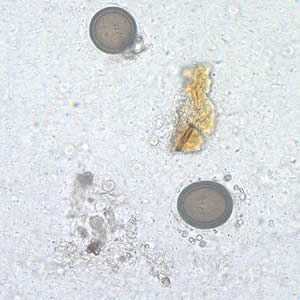
Figure A: Taenia sp. eggs in unstained wet mounts.

Figure B: Taenia sp. egg in unstained wet mounts.

Figure C: Iodine-stained wet mount of a Taenia sp. egg. Image courtesy of the Oregon State Public Health Laboratory.
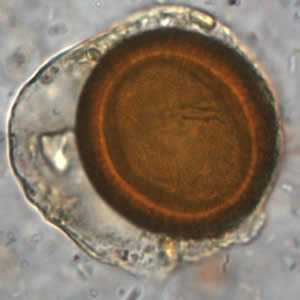
Figure D: Iodine-stained wet mount of a Taenia sp. egg. Image courtesy of the Oregon State Public Health Laboratory.
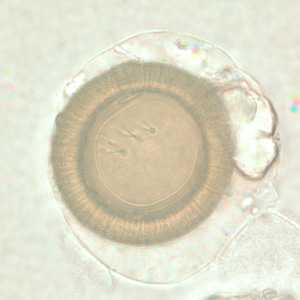
Figure E: Unstained Taenia sp. egg, teased from a proglottid of an adult. Four hooks can easily be seen in this image.
Taenia spp. scoleces.
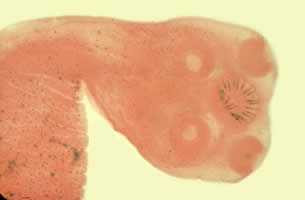
Figure A: Scolex of T. solium. Note the four large suckers and rostellum containing two rows of hooks.

Figure B: Scolex of T. solium. Note the four large suckers and rostellum containing two rows of hooks.
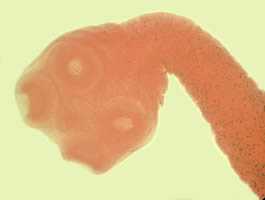
Figure C: Scolex of T. saginata. Note the four large suckers and lack of rostellum and rostellar hooks.
Taenia spp. proglottids.
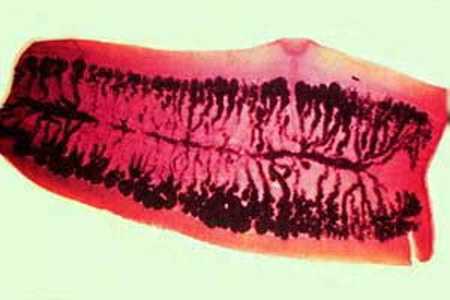
Figure A: Mature proglottid of T. saginata, stained with carmine. Note the number of primary uterine branches (>12).
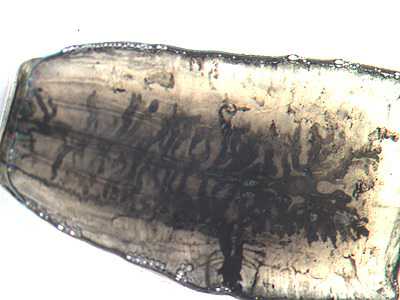
Figure B: Mature proglottid of T. saginata, stained with India ink. Note the number of primary uterine branches (>12). Image courtesy of the Orange County Public Health Laboratory, Santa Ana, CA.
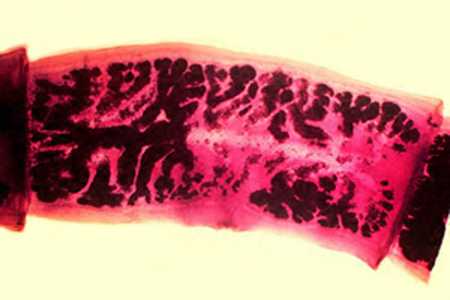
Figure C: Mature proglottid of T. solium, stained with carmine. Note the number of primary uterine branches (<13).

Figure D: Mature proglottid of T. solium, stained with India ink. Note the number of primary uterine branches (<13) in the lower specimen.

Figure E: Proglottid of T. saginata unstained. Image courtesy of the Oregon State Public Health Laboratory.
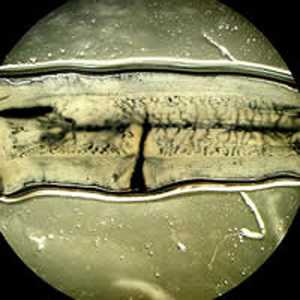
Figure F: The same proglottid as in Figure E injected with India ink, demonstrating the number of primary uterine branches (>12). Image courtesy of the Oregon State Public Health Laboratory.
Cross-sections of Taenia spp. stained with hematoxylin and eosin (H&E).

Figure A: Cross-section of a proglottid of Taenia sp., stained with H&E. Note the thick outer tegument and the loose parenchyma filling the body. Calcareous corpuscles (red arrows), characteristic of the cestodes, can be seen in the parenchyma. Image courtesy of the Washington State Public Health Laboratories.
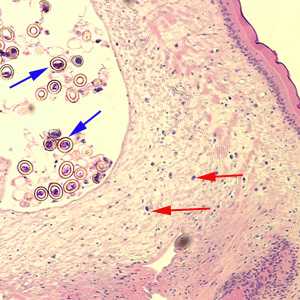
Figure B: Cross-section of a proglottid of Taenia sp., stained with H&E. Note the thick outer tegument and the loose parenchyma filling the body. Calcareous corpuscles (red arrows), characteristic of the cestodes, can be seen in the parenchyma. Eggs (blue arrows) can also be seen. Image courtesy of the Washington State Public Health Laboratories.
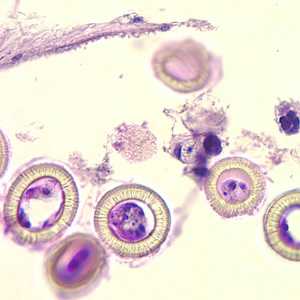
Figure C: Higher magnification of the image in Figure B, showing a close-up of the eggs. Note the characteristic striations, typical for the taeniids. Not visible in these images are the hooks commonly seen in cestode eggs. Hooks do not stain with H&E but are refractile and are visible with fine focusing of the microscope
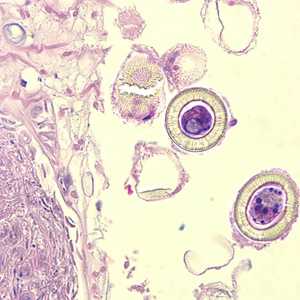
Figure D: Higher magnification of the image in Figure B, showing a close-up of the eggs. Note the characteristic striations, typical for the taeniids. Not visible in these images are the hooks commonly seen in cestode eggs. Hooks do not stain with H&E but are refractile and are visible with fine focusing of the microscope.
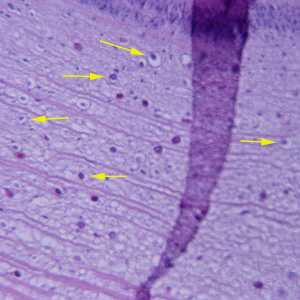
Figure E: Close-up of a cross-section of a Taenia sp. proglottid stained with H&E, showing numerous calcareous corpuscles (yellow arrows). Image courtesy of the Michael E. DeBakey V. A. Medical Center in Houston, TX.
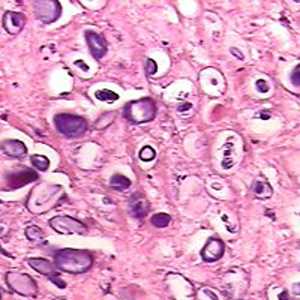
Figure F: Close-up of a cross-section of a Taenia sp. proglottid stained with H&E, showing numerous calcareous corpuscles. Image courtesy of Ameripath.

Figure A: Cross-section of a proglottid of Taenia sp., stained with H&E. Note the thick outer tegument and the loose parenchyma filling the body. Calcareous corpuscles (red arrows), characteristic of the cestodes, can be seen in the parenchyma. Image courtesy of the Washington State Public Health Laboratories.

Figure B: Cross-section of a proglottid of Taenia sp., stained with H&E. Note the thick outer tegument and the loose parenchyma filling the body. Calcareous corpuscles (red arrows), characteristic of the cestodes, can be seen in the parenchyma. Eggs (blue arrows) can also be seen. Image courtesy of the Washington State Public Health Laboratories.

Figure C: Higher magnification of the image in Figure B, showing a close-up of the eggs. Note the characteristic striations, typical for the taeniids. Not visible in these images are the hooks commonly seen in cestode eggs. Hooks do not stain with H&E but are refractile and are visible with fine focusing of the microscope

Figure D: Higher magnification of the image in Figure B, showing a close-up of the eggs. Note the characteristic striations, typical for the taeniids. Not visible in these images are the hooks commonly seen in cestode eggs. Hooks do not stain with H&E but are refractile and are visible with fine focusing of the microscope.

Figure E: Close-up of a cross-section of a Taenia sp. proglottid stained with H&E, showing numerous calcareous corpuscles (yellow arrows). Image courtesy of the Michael E. DeBakey V. A. Medical Center in Houston, TX.

Figure F: Close-up of a cross-section of a Taenia sp. proglottid stained with H&E, showing numerous calcareous corpuscles. Image courtesy of Ameripath.
Taenia spp. adults.
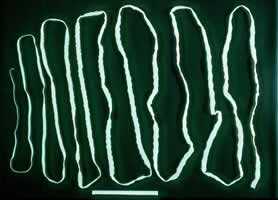
Figure A: Taenia saginata adult worm. The adult in this image is approximately 4 meters in length.
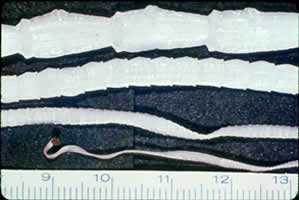
Figure B: Taenia saginata adult worm.
Laboratory Diagnosis
Microscopy
Microscopic identification of eggs and proglottids in feces is diagnostic for taeniasis, but is not possible during the first 3 months following infection, prior to development of adult tapeworms. Repeated examination and concentration techniques will increase the likelihood of detecting light infections. Nevertheless, identification of Taenia is not possible if solely based on microscopic examination of eggs, because all Taenia species produce eggs that are morphologically identical. Eggs of Taenia spp. are also indistinguishable from those produced by cestodes of the genus Echinococcus (tapeworms of dogs and other canid hosts). Microscopic identification of gravid proglottids (or, more rarely, examination of the scolex) allows species determination.
TAKE EXTREME CARE IN PROCESSING THE SPECIMENS! INGESTION OF EGGS CAN RESULT IN CYSTICERCOSIS!
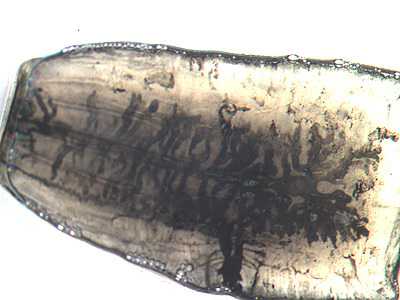
Figure B: Mature proglottid of T. saginata, stained with India ink. Note the number of primary uterine branches (>12). Image courtesy of the Orange County Public Health Laboratory, Santa Ana, CA.
Separation of T. saginata and T. solium is best accomplished by examination of mature proglottids. Taenia saginata has 12-30 primary lateral uterine branches, while T. solium has 7-13 primary lateral uterine branches. Visualization of the branches can be improved by clearing the specimen in lactophenol followed by India ink injection into the lateral genital pore. The procedure is as follows:
- Clear the formalin-fixed proglottids in lactophenol (50/50 liquefied phenol crystals in lactic acid) for at least 30 minutes (thicker specimen may take a few hours to overnight).
- Gently sandwich the proglottids between two glass microscope slides, with the genital pore exposed along the edge of the two slides.
- Using a small gauge (25 or 27 g) tuberculin syringe, slowly inject India ink into the genital pore.
- Allow the ink to flow down the uterine stem and into the primary uterine branches.
- Count the number of primary uterine branches to determine the species (7-13 for T. solium and 12-30 for T. saginata).
Antibody detection
May prove useful especially in the early invasive stages, when the eggs and proglottids are not yet apparent in the stools.
More on: Morphologic comparison with other intestinal parasites
Treatment Information
Praziquantel is the medication most often used to treat active taeniasis, given at 5-10 mg/kg orally once for adults and 5-10 mg/kg orally once for children. If the patient has cysticercosis in addition to taeniasis, praziquantel should be used with caution. Praziquantel is cysticidal and can cause inflammation around dying cysts in those with cysticercosis, which may lead to seizures or other symptoms. Niclosamide is an alternative, given at 2 g orally once for adults and 50 mg/kg orally once for children. After treatment, stools should be collected for 3 days to search for tapeworm proglottids for species identification. Stools should be re-examined for Taenia eggs 1 and 3 months after treatment to be sure the infection is cleared.
Praziquantel
Oral praziquantel is available for human use in the United States.
Note on Treatment in Pregnancy
DPDx is an education resource designed for health professionals and laboratory scientists. For an overview including prevention and control visit www.cdc.gov/parasites/.
- Page last reviewed: May 3, 2016
- Page last updated: May 3, 2016
- Content source:
- Global Health – Division of Parasitic Diseases and Malaria
- Notice: Linking to a non-federal site does not constitute an endorsement by HHS, CDC or any of its employees of the sponsors or the information and products presented on the site.
- Maintained By:


 ShareCompartir
ShareCompartir